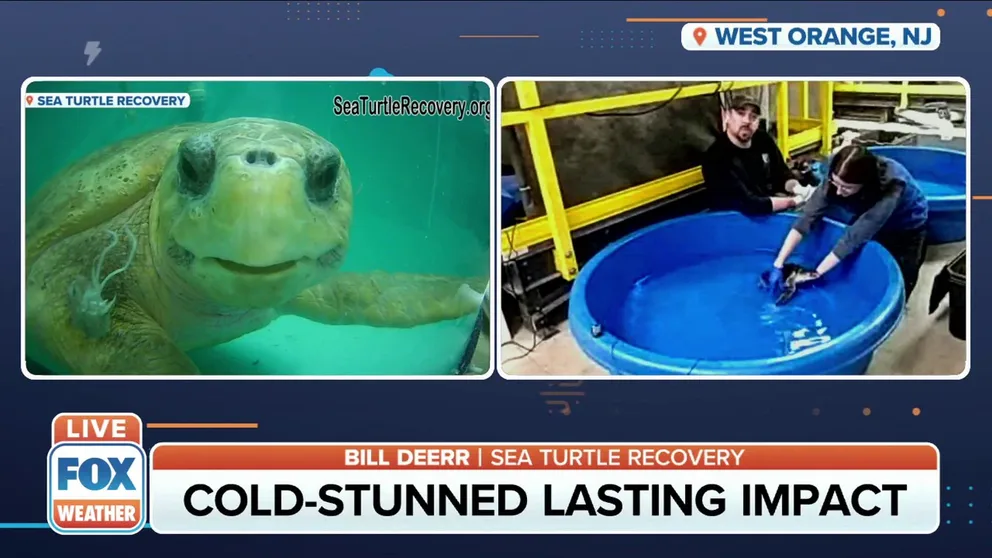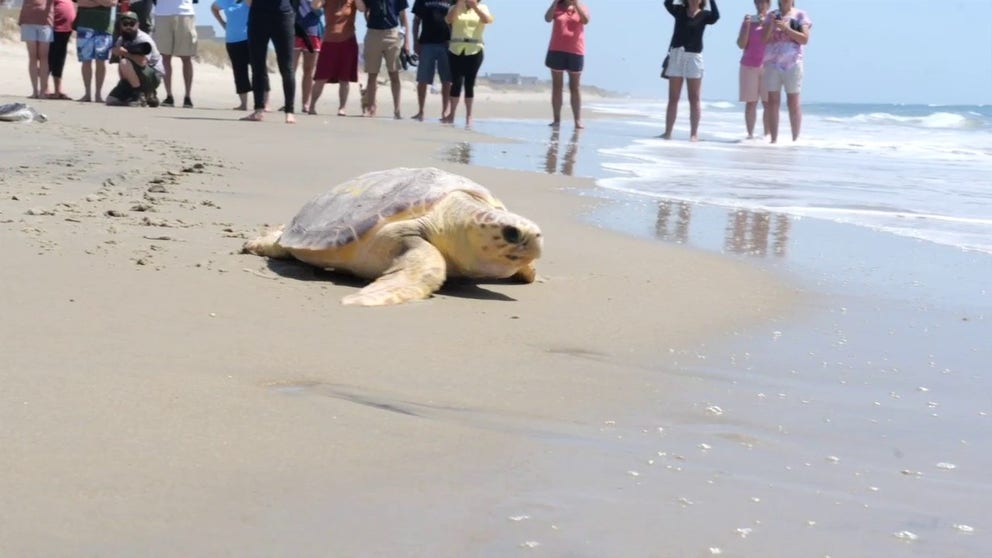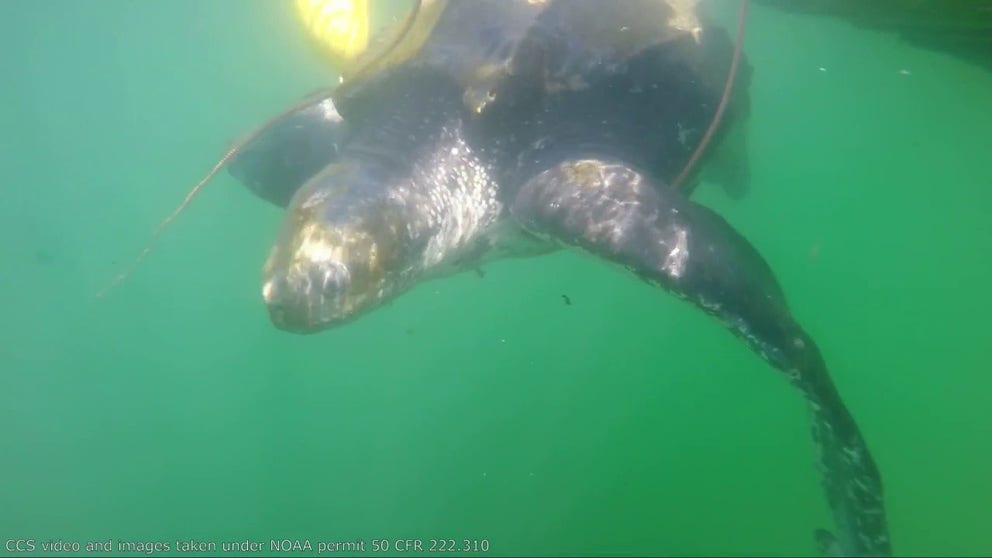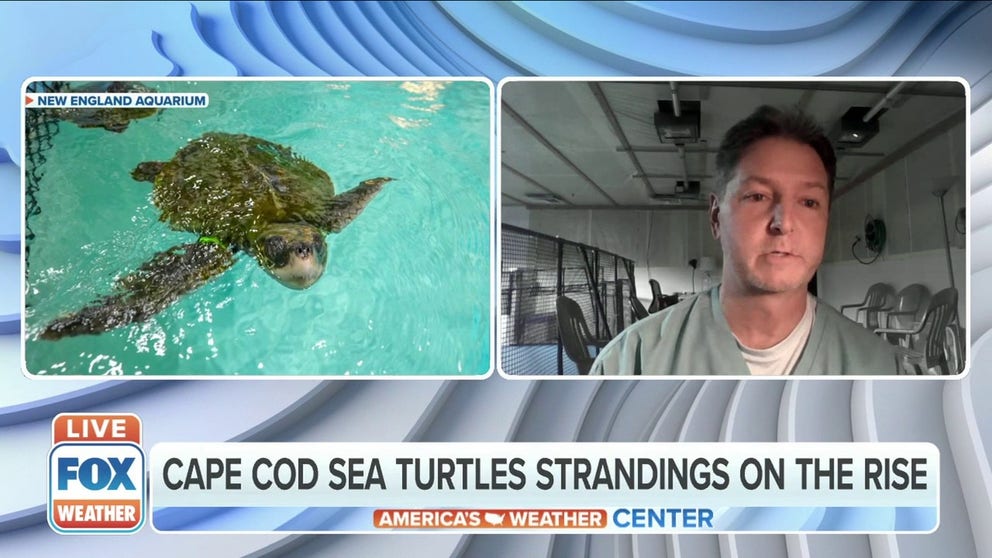What are 'cold-stunned' sea turtles?
While cold-stunning events vary by year, organizations will be on high alert to rescue as many sea turtles as possible when they’re found washed up on shore
Saving hypothermic sea turtles
The race is on to save hypothermic sea turtles that have been stranded.
The water off the coast of the United States is starting to get colder as we transition from fall to winter, and that can be deadly for hundreds or thousands of sea turtles that become "cold-stunned" and are unable to migrate back to warmer water.
And while cold-stunning events vary by year, organizations will be on high alert to rescue as many sea turtles as possible when they're found washed up on shore.
HOW TO WATCH FOX WEATHER ON TV
What is 'cold-stunning?'
Watch: 26 rehabilitated sea turtles released back into the Atlantic
The New England Aquarium along with partner organizations released dozens of rehabilitated sea turtles back into the Atlantic Ocean off the North Carolina coast.
Cold-stunning occurs when water temperatures drop below 50 degrees where sea turtles are present, according to NOAA Fisheries.
Sea turtles become weak and lethargic, which eventually leads to the turtles being unable to swim, so they float to the water's surface.
The current of the water and wind will eventually push the turtles ashore, and if temperatures remain cold and the turtles don't receive help, health conditions develop, and they can die.
Why do turtles become cold-stunned?
Watch: Center for Coastal Studies rescues entangled sea turtle
The Center for Coastal Studies shared video of crews working to help a leatherback sea turtle that became entangled in rope.
Every spring and summer, sea turtles follow the warm ocean currents of the Gulf Stream north.
The New England Aquarium said many turtles end up in the waters off the coast, including in Cape Cod Bay.
When the water gets colder, many of the turtles can't escape for reasons that aren't entirely known by researchers.
Turtles are cold-blooded, which means they rely on their surroundings to regulate their body temperature. So, when air and water temperatures drop, they become cold-stunned, which is a type of hypothermia, according to the New England Aquarium.
NOAA says cold-stunning is most likely to occur in shallow bays and other bodies of water where the water temperatures can quickly fall, as well as in areas where warmer bodies of water are obstructed by surrounding land, like Cape Cod.
THE RACE IS ON TO SAVE HYPOTHERMIC SEA TURTLES STRANDED IN CAPE COD BAY
What happens to sea turtles when they become cold-stunned?
Cape Cod sea turtle strandings on the rise
It's been a slow start to the annual sea turtle stranding season in Massachusetts, but the New England Aquarium is now treating more than 100 turtles suffering from hypothermia that have been rescued from Cape Cod beaches.
When it comes to a cold-stunning season, every year is different.
Last year, more than 500 turtles washed ashore on Cape Cod. Hundreds of them were rescued by the New England Aquarium and other organizations across the country.
The turtles were treated for various life-threatening conditions, including pneumonia and dehydration, due to their inability to feed.
According to NOAA, when the turtles become cold-stunned and float to the surface of the water, they become more vulnerable to predators.
And the cold temperatures can cause turtles to drown since they can't swim to safety.
Other conditions can occur, too. Exposure to cold air and water temperatures can affect the turtle's circulation, organ function and immune system, damaging its shell, eyes and skin.
Bacterial and fungal infections are also common in cold-stunned sea turtles.
Where do turtles become cold-stunned?
Rehabilitated sea turtle released into the Gulf of Mexico
Typhoon, a rehabilitated sea turtle rescued from the cold waters off Cape Cod, is seen swimming after a successful surgery. He was later released into the Gulf of Mexico. (Video: New England Aquarium)
According to NOAA, several areas from New England to the Gulf of Mexico can see cold-stunned sea turtles. Those locations include:
- Cape Cod Bay in Massachusetts
- Long Island Sound in New York
- Pamlico Sound in North Carolina
- Mosquito Lagoon and the surrounding areas of the Indian River Lagoon in Florida
- St. Joseph Bay in Florida
- Bays statewide in Texas, including Corpus Christi Bay, Matagorda Bay and Upper/Lower Laguna Madre
What to do to help cold-stunned sea turtles
Sea turtles that become cold-stunned most likely need help from organizations like the New England Aquarium and SeaWorld.
In fact, SeaWorld successfully returned rehabilitated and critically endangered turtles to the ocean after becoming stranded in Cape Cod Bay in November 2021.
Those turtles were released into the waters of the Canaveral National Seashore and joined the more than 2,500 sea turtles that SeaWorld has rescued since 1980.
Many sea turtles require veterinary care and rehabilitation before being returned to the wild, and sometimes that can take months.
Anyone who comes across a cold-stunned sea turtle should know that it cannot be put back into the water.
NOAA and other organizations ask that if a cold-stunned sea turtle is spotted, it should be reported to authorities so the right organizations, teams and volunteers can respond to the area and assist.




